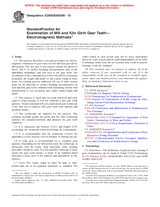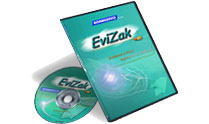Wir benötigen Ihre Einwilligung zur Verwendung der einzelnen Daten, damit Sie unter anderem Informationen zu Ihren Interessen einsehen können. Klicken Sie auf "OK", um Ihre Zustimmung zu erteilen.
ASTM E2905/E2905M-12
Standard Practice for Examination of Mill and Kiln Girth Gear Teeth—Electromagnetic Methods
Automatische name übersetzung:
Standard Praxis für die Prüfung von Mill and Kiln Zahnkranz Zähne & mdash; Elektromagnetische Methoden
NORM herausgegeben am 15.11.2012
Informationen über die Norm:
Bezeichnung normen: ASTM E2905/E2905M-12
Anmerkung: UNGÜLTIG
Ausgabedatum normen: 15.11.2012
SKU: NS-46243
Zahl der Seiten: 8
Gewicht ca.: 24 g (0.05 Pfund)
Land: Amerikanische technische Norm
Kategorie: Technische Normen ASTM
Die Annotation des Normtextes ASTM E2905/E2905M-12 :
Keywords:
alternating current field measurement, crack, eddy current, eddy current array, electromagnetic examination, gear, gear examination, gear teeth, girth gear, kiln gear, macro-pitting, micro-pitting, mill gear, nondestructive examination, open gear, pitting, ICS Number Code 21.200 (Gears)
Ergänzende Informationen
| Significance and Use | ||||||||||||||||||||
|
5.1 Visual interpretation of gear teeth condition is different from examining for cracks or early signs of macro-pitting. Visual interpretation is referred to ANSI/AGMA 1010 E-95. 5.1.1 The purpose of using eddy-current array for girth gear teeth examination is it drastically reduces examination time; covers a large area in one single pass; provides real-time cartography of the examined region, facilitating data interpretation; and improves reliability and probability of detection (POD). One tooth can be examined in less than 30 seconds. 5.1.2 The purpose of using
alternating current field measurement is its ability to size
accurately surface-breaking cracks.
5.1.3 This practice is a useful tool for a condition-based monitoring program. 5.2 The examination results may then be used by qualified personnel or organizations to assess remaining service life or other engineering characteristics (beyond the scope of this practice). This practice is not intended for the examination of non-surface-breaking discontinuities. |
||||||||||||||||||||
| 1. Scope | ||||||||||||||||||||
|
1.1 This practice describes a two-part procedure for electromagnetic evaluation on gear teeth on mill and kiln gear drives and pinions. The first part of this practice details the ability to detect 100 % of surface-breaking discontinuities only in the addendum, dedendum, and root area of the gear tooth. The second part of the examination is to have the ability to measure accurately the length and depth of any cracks found in these areas. No existing practice addresses the use of eddy current array for the detection of surface-breaking discontinuities on mill and kiln gear teeth combined with alternating current field measurement to size accurately any cracks found, length and depth. 1.2 This practice is used only for crack detection and early signs of macro-pitting. It will not illustrate a full gear tooth analysis. Visual examination by an experienced gear technician is the only way to analyze fully gear teeth wear patterns and potential failure. 1.3 Two technicians are required for this practice. One technical assistant guides the probe and the other technician operates the computer/software and analyzes the gear teeth condition. 1.4 It is important that Practice E2261 and Guides E709 accompany the technician when performing the examination. 1.5 It is recommended that the technician reviews the appendixes in this practice well in advance of starting the job. 1.6 A clean gear is recommended for a complete gear analysis. Depending on the lubrication used, the technician, in discussion with the client, shall determine what cleaning procedure should be used. If a non-asphaltic lubricant is used, ensure the gear teeth surface is clean. If an asphaltic-based lubricant is used, refer to the annexes and appendixes in this practice. 1.7 Units—The values stated in either SI units or inch-pound units are to be regarded separately as standard. The values stated in each system may not be exact equivalents; therefore, each system shall be used independently of the other. Combining values from the two systems may result in nonconformance with the standard. 1.8 This standard does not purport to address all of the safety concerns, if any, associated with its use. It is the responsibility of the user of this standard to establish appropriate safety and health practices and determine the applicability of regulatory limitations prior to use. |
||||||||||||||||||||
| 2. Referenced Documents | ||||||||||||||||||||
|
Empfehlungen:
EEviZak – alle Gesetze einschließlich ihrer Evidenz in einer Stelle
Bereitstellung von aktuellen Informationen über legislative Vorschriften in der Sammlung der Gesetze bis zum Jahr 1945.
Aktualisierung 2x pro Monat!
Brauchen Sie mehr Informationen? Sehen Sie sich diese Seite an.




 Cookies
Cookies
